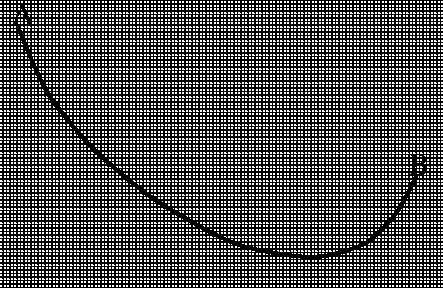Answer to the Question 07/98
SLIPPERY SLOPEThe question was:

A body is sliding along the curve which is shown to-scale in the above figure. It starts at point A, an slides with friction coefficient k. Describe a method to determine the point B at which the body stops.
(7/98) The problem has been solved correctly by Omer Edhan (e-mail edhan@netvision.net.il) and Itzhak Shapir (e-mail microwav@rafael.co.il.
The answer: Starting from point A draw a straight line of slope -k. The point of intersection of the line with the curve is the point B where the body stops.
The solution:
The friction force F=k*N, where N is the normal force between the body and the slope. N on a straight slope is simply equal to the weight P of the body multiplied by cos(alpha), where alpha is the angle between the tangent to the slope and the horizontal direction. Since the slope is curved an additional component should be added because of the presence of centripetal force. However, if we assume that the radius of curvature R is always large while the velocity V is small (more accurately, that V2/R is much smaller than the acceleration of free fall) then we may neglect the effects of curvature.
The element of work performed by the friction force when the body is displaced by amount ds along the curve is
dW=-k*P*ds*cos(alpha)=-k*P*dx,
where dx is the horizontal displacement element. Thus the total work performed by friction forces is -k*P*X where X the total horizontal displacement. At point B this work must be equal to the change in potential energy P*Y, where Y is the vertical displacement. Thus, k=-Y/X, and consequently the position of B is determined by the intersection of the curve with a straight line with slope -k.
 Back to "front page"
Back to "front page"